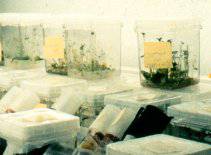
FAQ About Indoor Plant Propagation Using Tissue Culture

What is tissue culture in plant propagation?
Tissue culture is a technique used to propagate plants under sterile, controlled conditions. It involves the cultivation of plant cells, tissues, or organs in an artificial medium separate from the parent plant. This method ensures mass production of plants, with genetic accuracy and often improved resistance to diseases.

How does tissue culture benefit indoor plant propagation?
Tissue culture allows for rapid multiplication of plants in limited spaces, providing genetically identical plants suitable for indoor environments. It minimizes disease transmission, supports biodiversity by allowing rare species to be cultivated, and is useful in conserving endangered plants.

What types of indoor plants can be propagated using tissue culture?
Many indoor plants can be propagated using tissue culture, including popular houseplants like orchids, ferns, anthuriums, and various succulents. The technique is particularly effective for plants that are difficult to propagate using traditional methods.

What materials are needed for plant tissue culture?
The essential materials for plant tissue culture include explants (the plant material used to start the culture), a sterile nutrient medium, growth regulators, and containers such as Petri dishes or flasks. Additionally, a sterile environment, like a laminar flow hood, and sterilization tools are crucial.

What challenges are associated with tissue culture for indoor plant propagation?
Challenges include maintaining a sterile environment to prevent contamination, the initial cost of setting up a laboratory, and the technical expertise required to manage the cultures. Overcoming genetic mutations and ensuring successful acclimatization to soil are also significant challenges.

How is sterility maintained in plant tissue culture?
Sterility in tissue culture is maintained using an autoclave to sterilize equipment and media, working in a laminar airflow cabinet to prevent contamination, and practicing good aseptic techniques, such as wearing gloves and using disinfectants.

What is the role of a nutrient medium in tissue culture?
The nutrient medium provides the necessary minerals, vitamins, and growth regulators to support cell division and growth in plant tissue cultures. It acts as a support system for plant development, with its composition tailored to the specific needs of different plant species.

Can home gardeners perform tissue culture propagation?
While tissue culture is more commonly performed in specialized labs, it can be undertaken by home gardeners with the right equipment and skills. Home tissue culture kits are available, but it requires knowledge, precision, and a sterile environment for successful propagation.

Why is tissue culture considered a sustainable method of plant production?
Tissue culture minimizes the need for large growing areas and reduces pesticide use by ensuring disease-free plants. It promotes conservation by allowing for the multiplication of endangered plant species, and helps prevent overharvesting from natural habitats.

How long does it take to propagate plants using tissue culture?
The time required for tissue culture propagation varies depending on the plant species and growth conditions. Generally, it takes several weeks to months from initial culture to plantlet formation, followed by acclimatization to a typical indoor environment.
